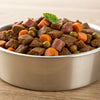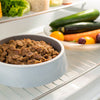Should Dogs Get Wet Food? Understanding the Pros and Cons
- Houndsy
Table of Contents
- Introduction
- Understanding Wet and Dry Dog Food
- Benefits of Wet Dog Food
- Drawbacks of Wet Dog Food
- Benefits of Dry Dog Food
- Drawbacks of Dry Dog Food
- Mixing Wet and Dry Food
- Conclusion
Introduction
Imagine this: you watch your dog approach their food bowl, tail wagging excitedly as you pour in their meal. But instead of diving headfirst into the kibble, your furry friend sniffs tentatively, then turns away, leaving you wondering why their appetite seems to have diminished. If you've ever encountered this scenario, you might be asking yourself if a change to wet food could reignite that enthusiasm at mealtime.
The debate between wet and dry dog food is one that many pet parents grapple with. Recent surveys show that nearly 30% of dog owners experience confusion when choosing the right type of diet for their pets, highlighting the challenge in making informed decisions. We find ourselves pondering the benefits of wet food versus dry—what truly is best for our pets' health and happiness?
In this blog post, we will explore the essential considerations regarding whether dogs should get wet food, outlining both the benefits and drawbacks. From nutritional content to palatability, we’ll dive deeper into the world of canine diets, providing insights that can help elevate your dog-feeding experience to new heights of convenience and joy. Prepare to reflect on your own pet feeding routine and discover how a balance of wet and dry food may suit your furry friend’s unique needs.
As we progress through this article, our goal is to provide clarity on the nutritional aspects, advantages, and inconveniences of wet food. By the end, you’ll be equipped with the knowledge required to make the most informed decision for your pet’s dietary future.
Understanding Wet and Dry Dog Food
The Basics of Dog Food
Before diving into the specifics, let's clarify the two main types of dog food: wet and dry.
-
Wet Dog Food: Commonly known as canned food, wet dog food typically boasts a high moisture content, ranging from 70% to 78%. This type of food is primarily favored for its palatability and texture, often more appealing to dogs due to its aroma and taste similarity to fresh meat.
-
Dry Dog Food: Often referred to as kibble, dry dog food generally contains less than 10% moisture. It provides the convenience of easy portion control and storage but can be less appealing to some dogs, particularly picky eaters.
Nutritional Considerations
Both types of food can provide a nutritionally balanced diet for your dog, but they do differ vastly in processing. Wet food is often more protein-dense and low in carbohydrates, while dry food may contain added ingredients such as grains and fillers.
-
Wet Food Processing: Wet food is produced by grinding protein sources and combining them with grains, vitamins, and minerals before cooking and canning. This process often results in higher protein and fat levels, which some dogs might benefit from.
-
Dry Food Processing: Dry kibble is extruded, compacting ingredients into small, shelf-stable nuggets that can last for months. This method sometimes leads to added preservatives and lower moisture content.
Understanding the nutrition each type offers is crucial in determining the best diet for your canine companion and addressing specific health needs.
Benefits of Wet Dog Food
1. Increased Palatability
One of the most significant advantages of wet dog food is its taste. Its moisture content and aroma make it more enticing, particularly for fussy eaters. Many dogs who may turn their noses up at kibble will happily dive into a bowl of wet food. This appeal can be especially beneficial if your dog is recovering from illness or simply not as eager to eat.
2. Enhanced Hydration
Adequate hydration is vital for our dogs, especially those who may not drink enough water on their own. Wet food provides an excellent hydration boost, making it a favorable option for dogs with urinary or kidney issues, as well as those living in hotter climates. Increased moisture can help combat the risk of dehydration, keeping our pets healthy and robust.
3. Easier Chewing and Digestion
Wet dog food tends to be softer and requires less effort to chew, which is a vital consideration for senior dogs or those with dental issues. The tender texture can make mealtime easier and more enjoyable for them, ensuring they receive necessary nutrients without the stress that harder kibble might cause.
4. Nutritional Benefits
Canned dog foods often possess higher levels of protein due to meat being the primary ingredient, making it a good choice for active or working dogs. Additionally, wet food tends to contain fewer carbs and fillers compared to some dry foods, potentially leading to weight management advantages.
Drawbacks of Wet Dog Food
1. Cost Considerations
While wet food can provide many benefits, it often comes at a higher cost compared to dry food. The packaging, production, and lower shelf-life contribute to a higher price point. For pet parents operating on a budget, this factor can be a significant barrier.
2. Storage and Spoilage Issues
Wet food has a shorter lifespan once opened. After being exposed to air, wet food can spoil quickly and should be consumed within a few days. This necessity to refrigerate opened containers and toss out leftovers can lead to increased waste, particularly for dogs that prefer to graze instead of finishing their meals in one go.
3. Potential Dental Issues
Dogs who primarily consume wet food may be at risk for dental problems. The lack of abrasive action during chewing can promote tartar buildup, which could lead to periodontal disease if a regular dental routine is not established. For this reason, maintaining a consistent teeth-cleaning regimen is vital.
4. Nutritional Considerations
Not all wet foods are created equal. Many commercial brands contain fillers, artificial preservatives, or low-quality ingredients. As dog parents, it’s crucial to scrutinize the ingredient list and nutritional value to ensure the healthiness of the food you select.
Benefits of Dry Dog Food
1. Cost-Effectiveness
Dry dog food is generally less expensive than its wet counterpart. With longer shelf life and better convenience of storage, pet owners may find kibble a more feasible option for everyday feeding.
2. Dental Health Benefits
While dry food may not clean a dog’s teeth effectively, the chewing action can still help reduce the build-up of tartar compared to wet food. Additionally, certain brands are formulated with dental health in mind, adding specific textures and ingredients that promote oral hygiene.
3. Convenience
Kibble is easier to measure, portion, and store, eliminating worries about spoilage. It remains a preferred choice for busy pet parents seeking a hassle-free feeding solution. You can pour out precise amounts without the mess that wet food might create.
4. Food Enrichment
Dry food works excellently in food puzzles and interactive feeders, promoting mental stimulation as dogs engage in problem-solving while mealtime transforms into a fun activity.
Drawbacks of Dry Dog Food
1. Lower Moisture Content
A significant drawback of dry food is its low moisture content, potentially leading to hydration issues for certain dogs, especially those that are not avid drinkers. This factor makes it essential for conscientious pet parents to monitor their water intake and adjust feeding habits accordingly for optimal wellbeing.
2. Less Appealing
Many dogs find dry food less palatable than wet food. Some fussy eaters may only engage with kibble if it's mixed or topped with additional flavor-enhancing components.
3. Gastrointestinal Sensitivities
For dogs with sensitive stomachs or particular dietary restrictions, dry food with high grain or gluten content could exacerbate digestive issues. Consulting with your veterinarian about the best diet for your dog’s specific needs is always advisable.
Mixing Wet and Dry Food
For many pet parents, a successful solution lies in combining both wet and dry food. This approach offers the best of both worlds—providing hydration, palatability, and dental health benefits, all while ensuring that feeding remains convenient.
Benefits of Mixing:
- Flavor and Texture Variety: Mixing can entice picky eaters while giving dogs dietary diversity.
- Balanced Nutritional Profile: A combination can help dogs achieve a well-rounded intake of nutrition.
- Cost Management: Using dry food as a base and adding wet food can lower the overall food expenses while still tantalizing your dog’s taste buds.
Important Tips:
- Transition Gradually: If you're new to mixing or switching foods, introduce changes slowly to avoid digestive disturbances.
- Monitor Portions: Be mindful of calorie counts—ensure that the total amount of combined food meets your dog’s dietary needs to maintain a healthy weight.
- Consult a Vet: Discuss feeding styles with your veterinarian, especially when mixing foods, to get tailored advice for your canine companion.
Conclusion
Choosing the ideal diet for our dogs can often feel like navigating a labyrinth of options. Once armed with a deeper understanding of wet and dry dog food, we can make informed decisions that enhance our pets' health and wellbeing. It's clear that the benefits and drawbacks of each type all boil down to individual pet needs and preferences.
We hope this guide empowers you to reflect upon your current dog feeding routine, contemplate how you can integrate the Houndsy Kibble Dispenser for enhanced convenience, and elevate mealtime into an exciting and nourishing experience. After all, only the best will do when it comes to our beloved fur babies.
FAQs
1. Is wet dog food more nutritious than dry dog food?
Not necessarily. Both can provide balanced nutrition; it depends on the brand and formulation you choose. Always check ingredient labels.
2. Can I feed my dog only wet food?
Yes, many dogs thrive on wet food diets, but it should be nutritionally balanced. Consult your vet for recommendations that suit your dog's needs.
3. Will wet food help my dog stay hydrated?
Absolutely! The high moisture content in wet food can significantly aid in keeping dogs hydrated, especially those that do not drink enough water.
4. How can I prevent dental issues in dogs that eat only wet food?
Regular dental care is crucial. Consider dental chews or a routine teeth cleaning to help combat tartar buildup.
5. How much should I feed my dog if I mix wet and dry food?
Consult your veterinarian for accurate calorie counts based on your dog's size and activity level to prevent overfeeding.
If you're looking for an elevated feeding experience, check out the Houndsy Kibble Dispenser designed to simplify how we feed our dogs while enhancing the aesthetic of your home. Let’s make mealtime enjoyable for both you and your beloved pets.












